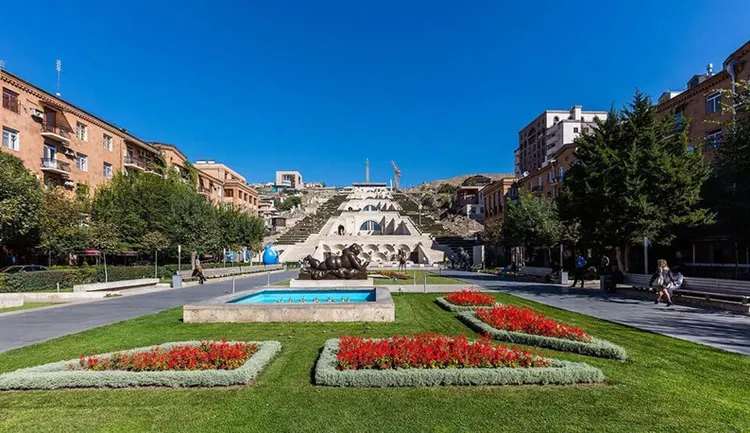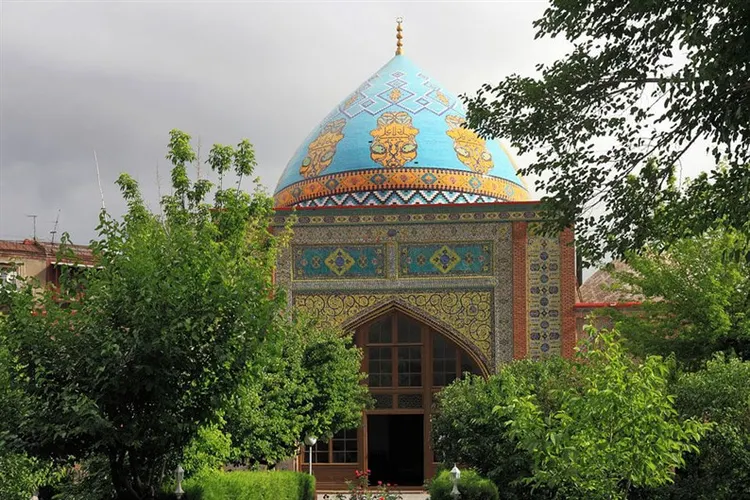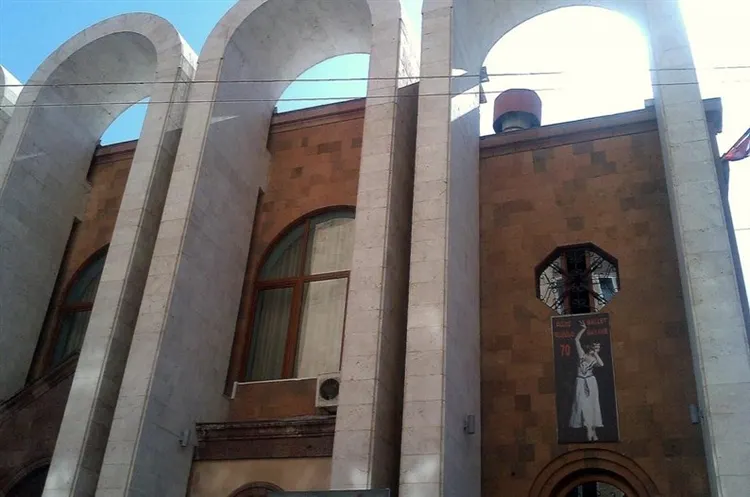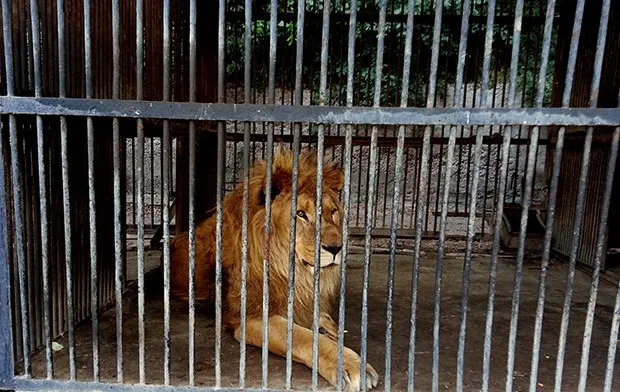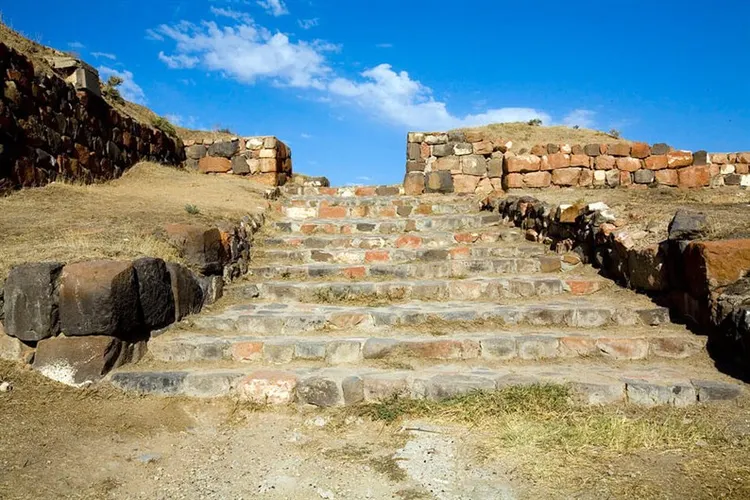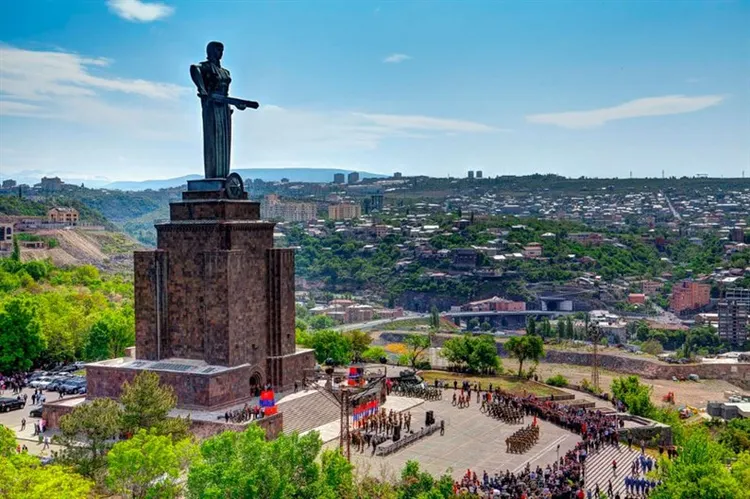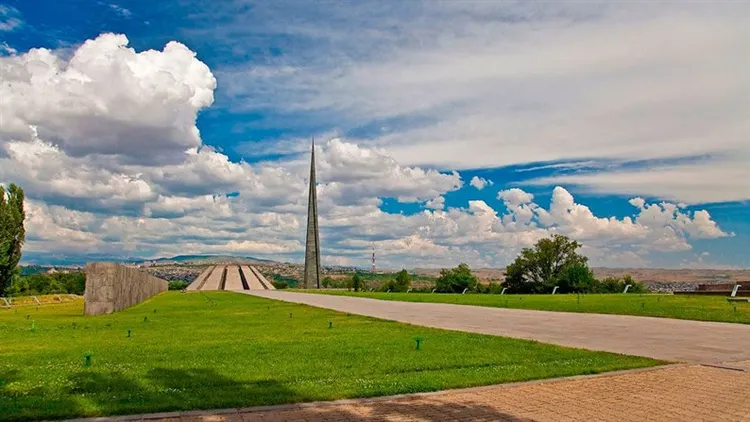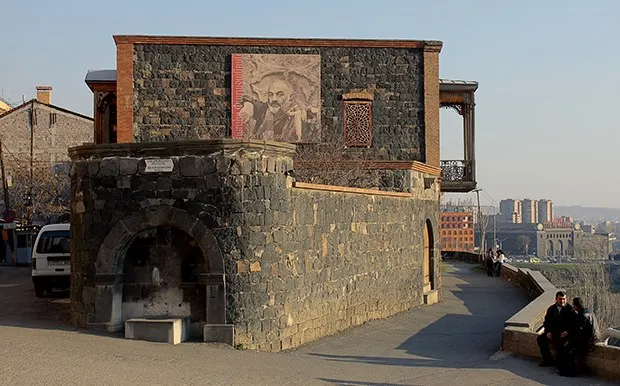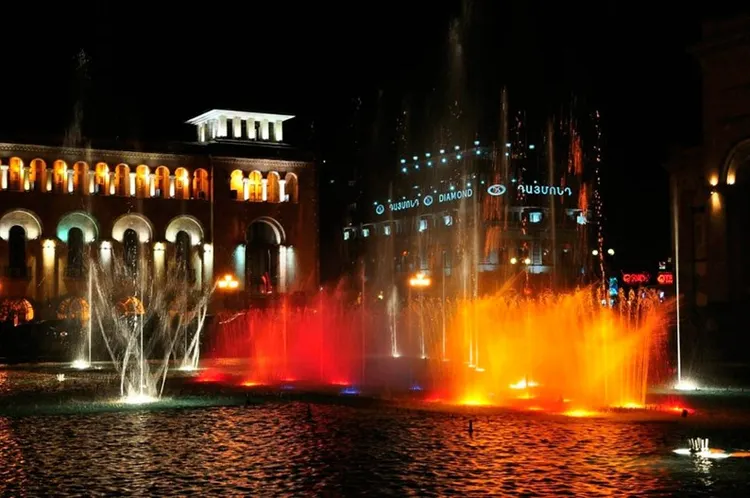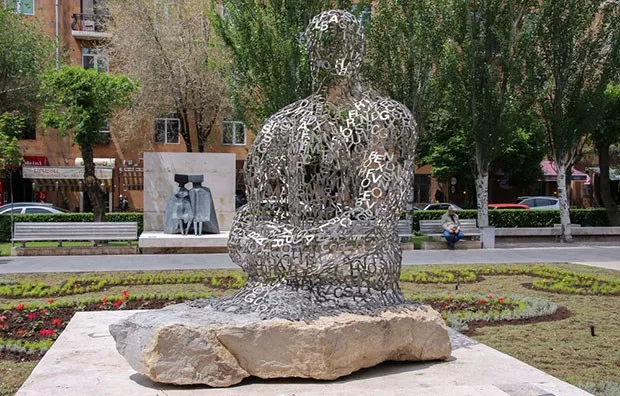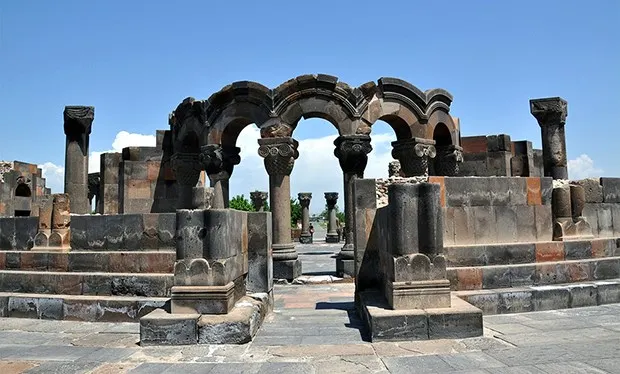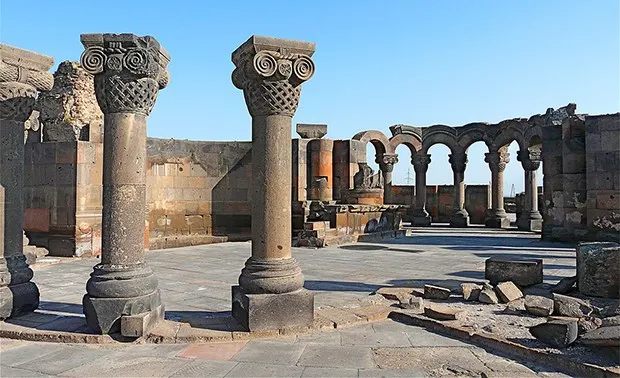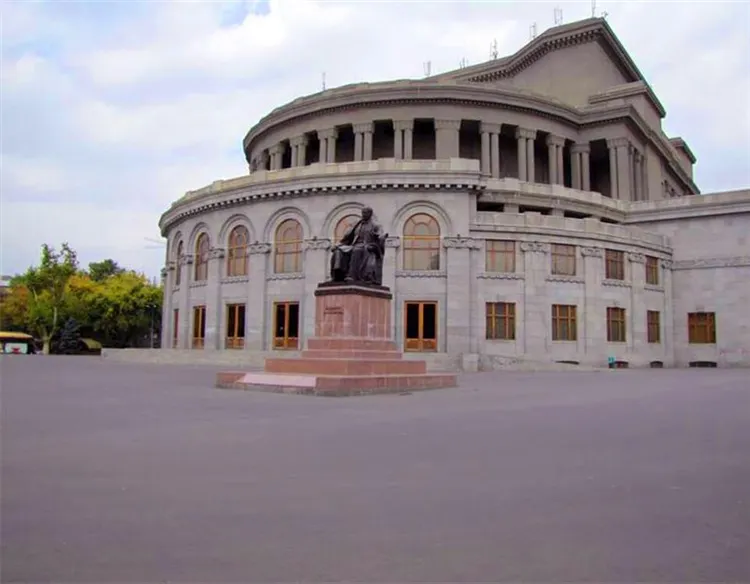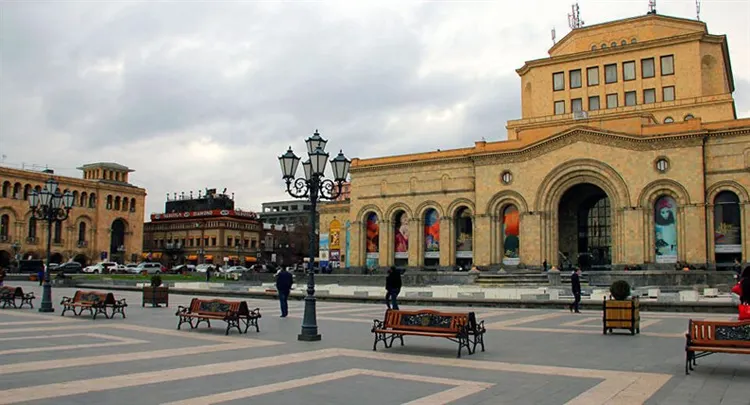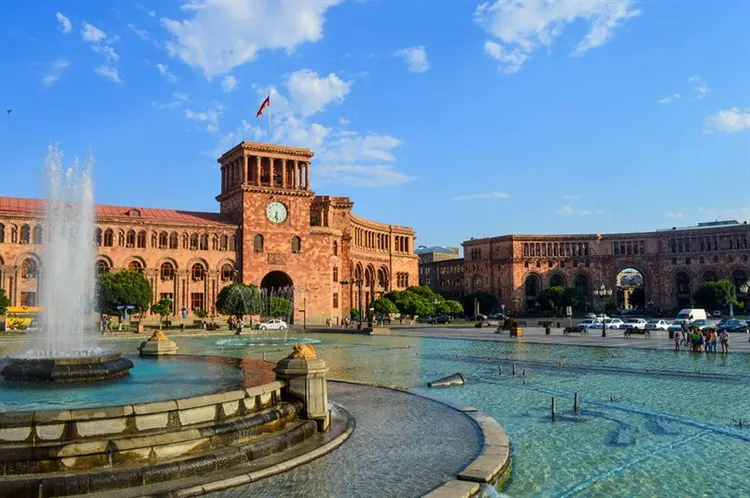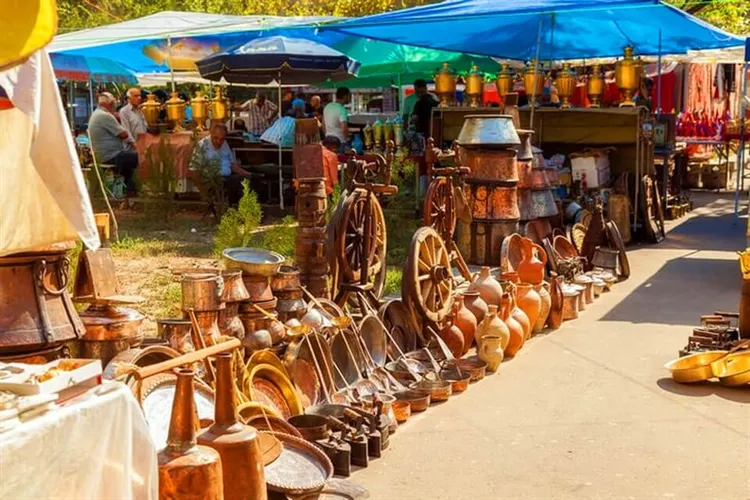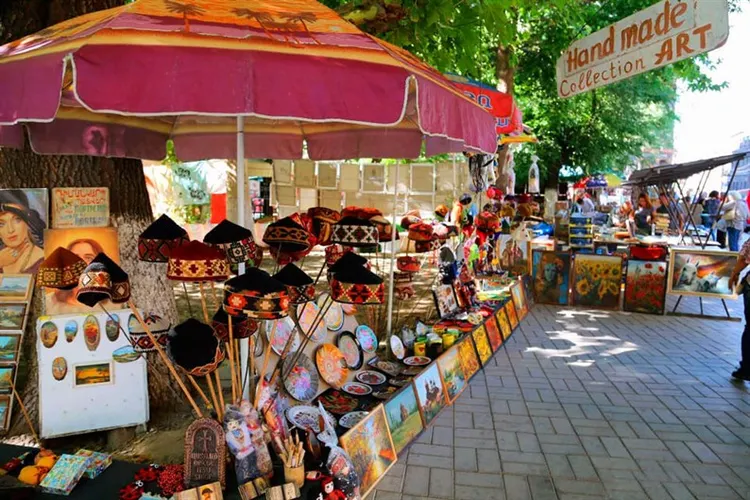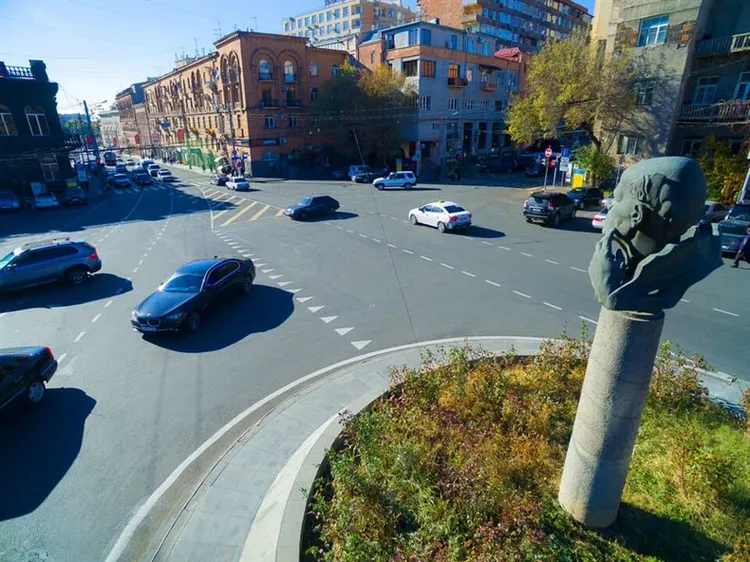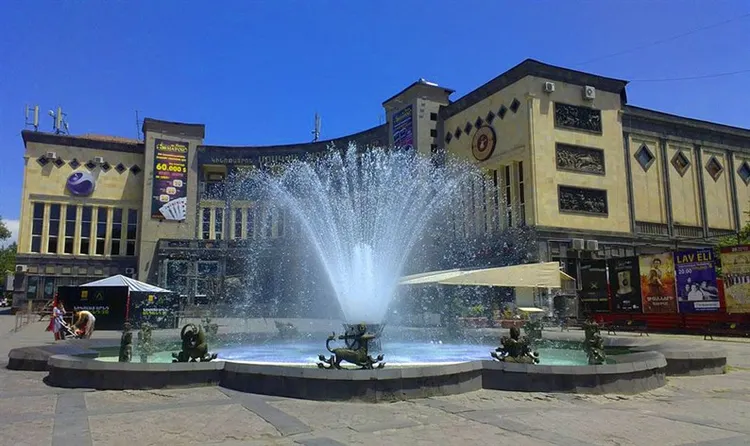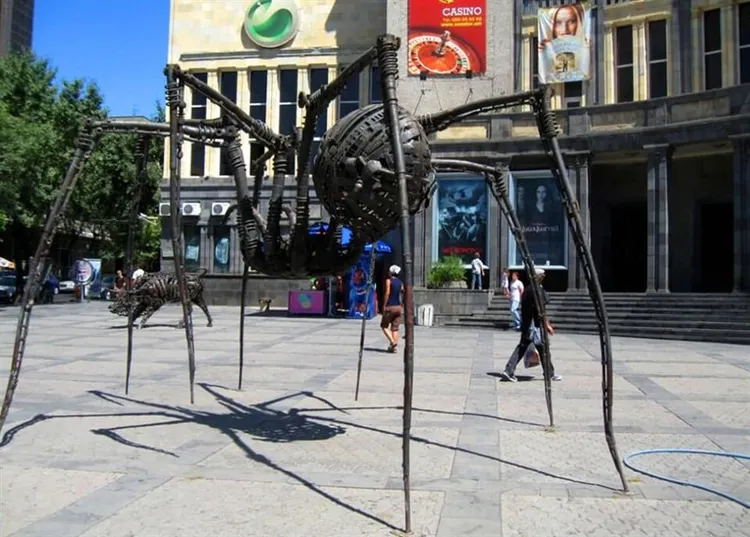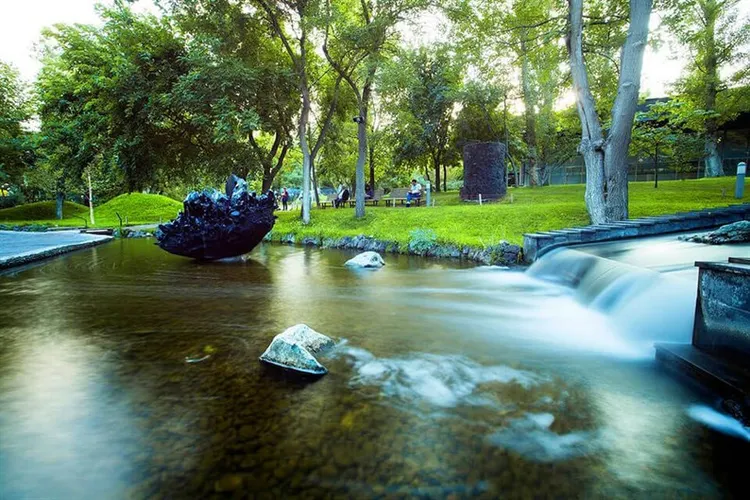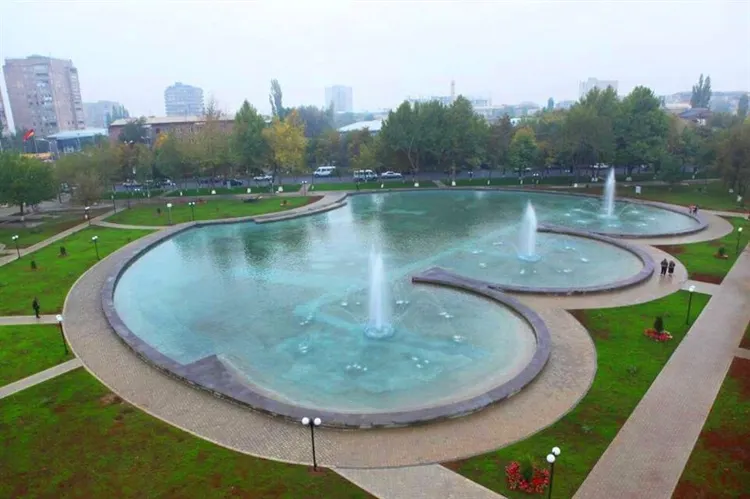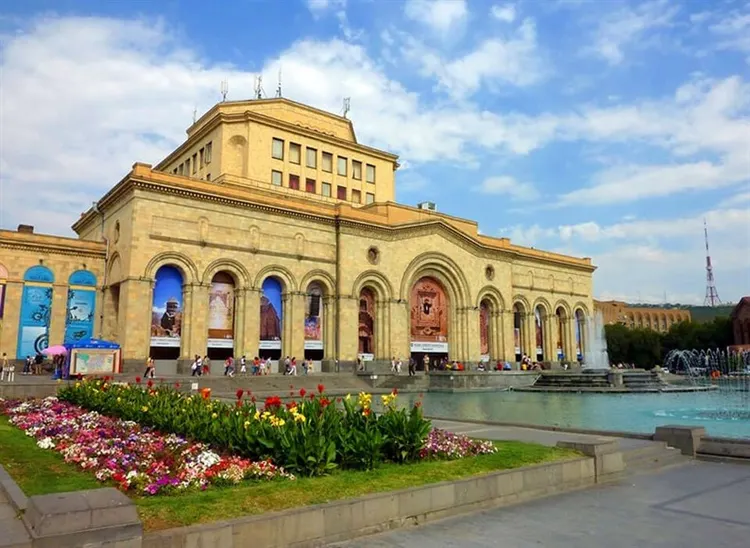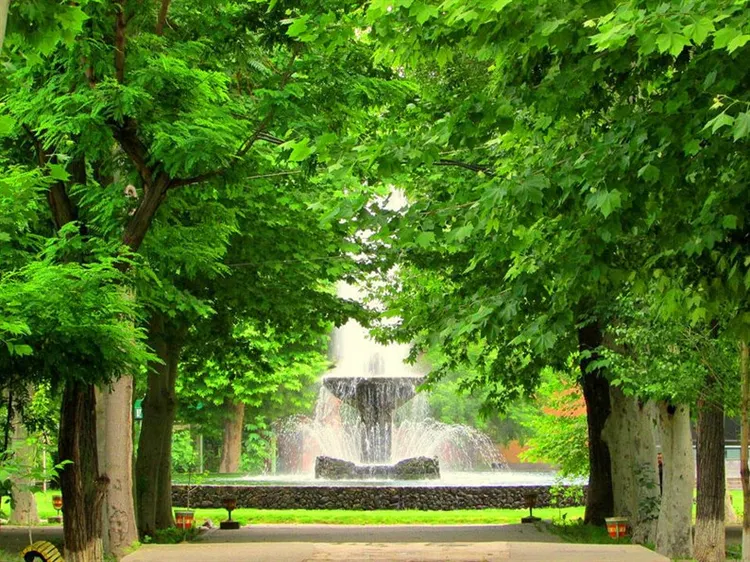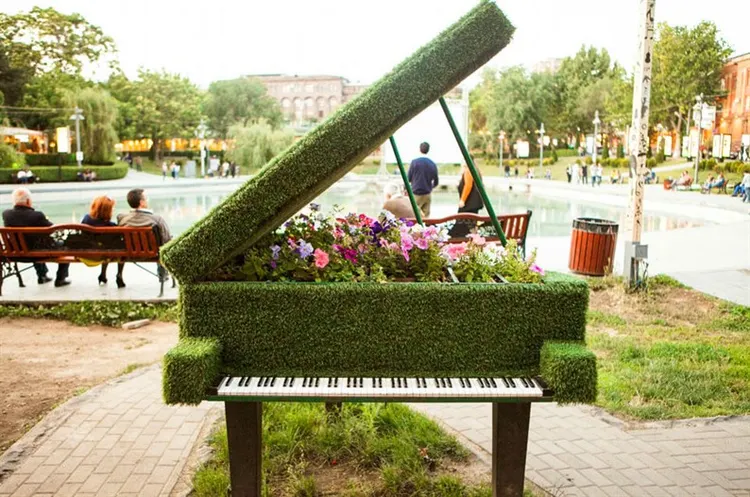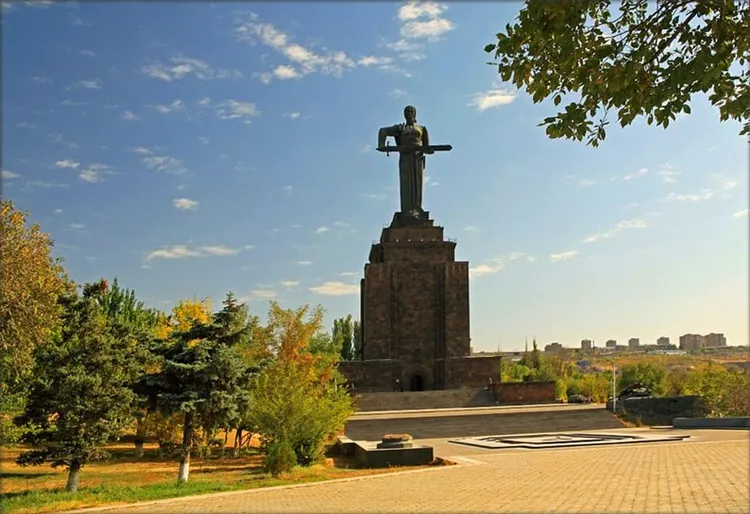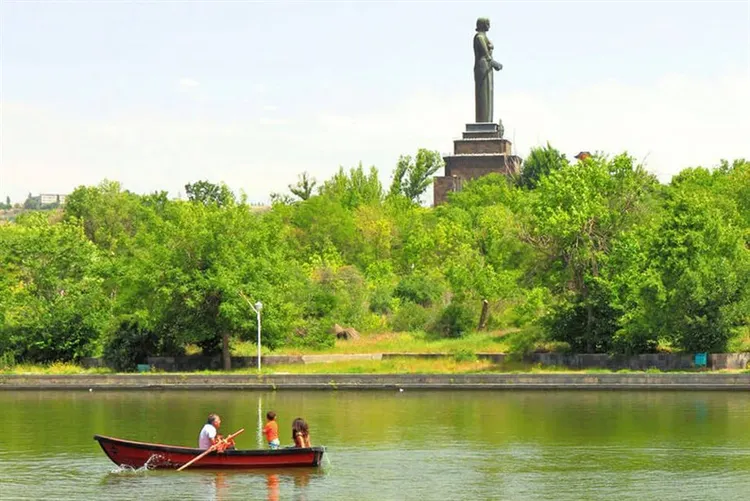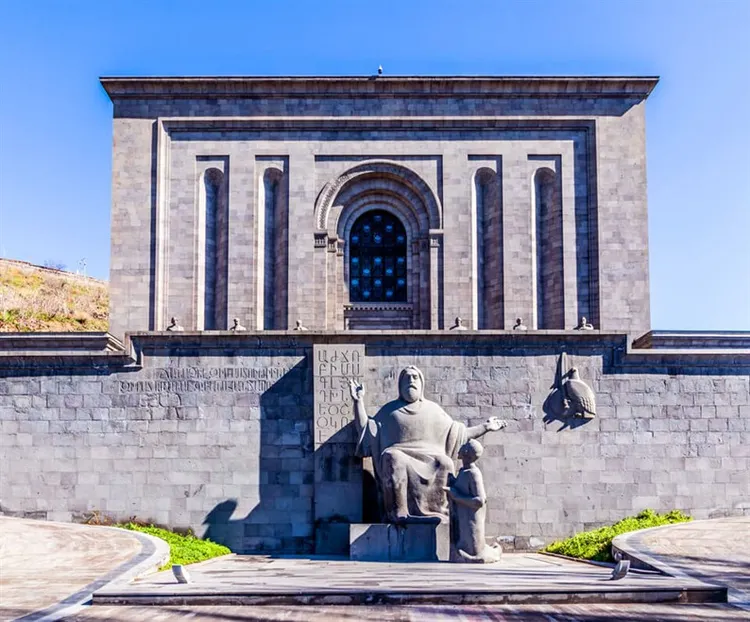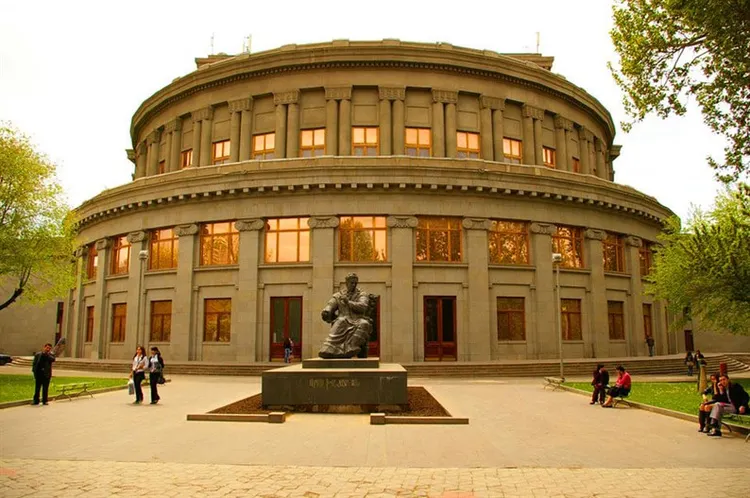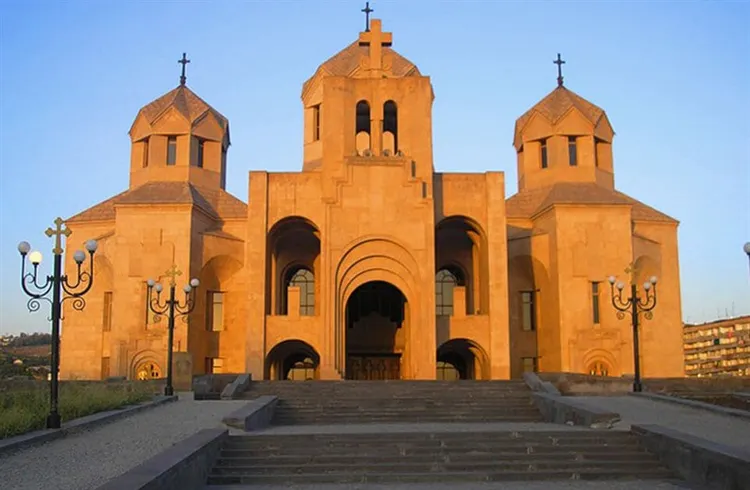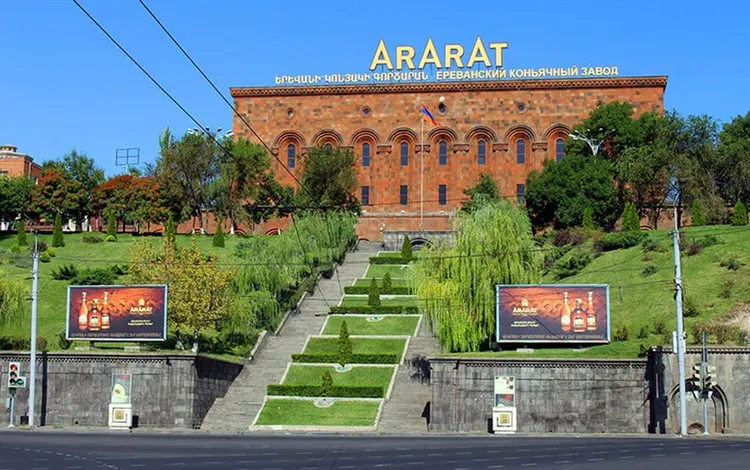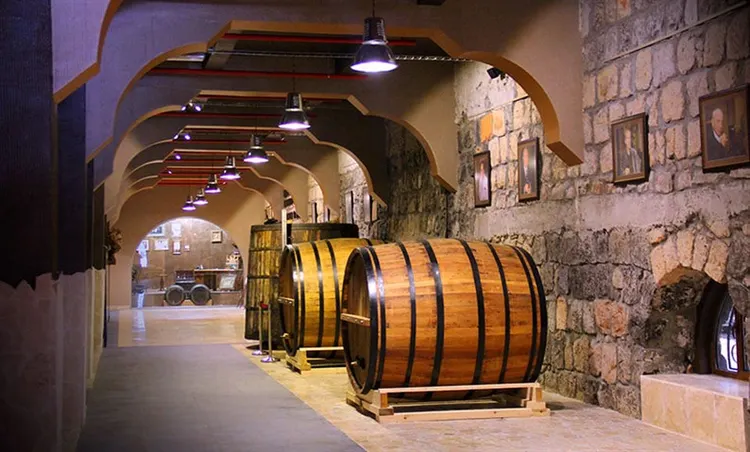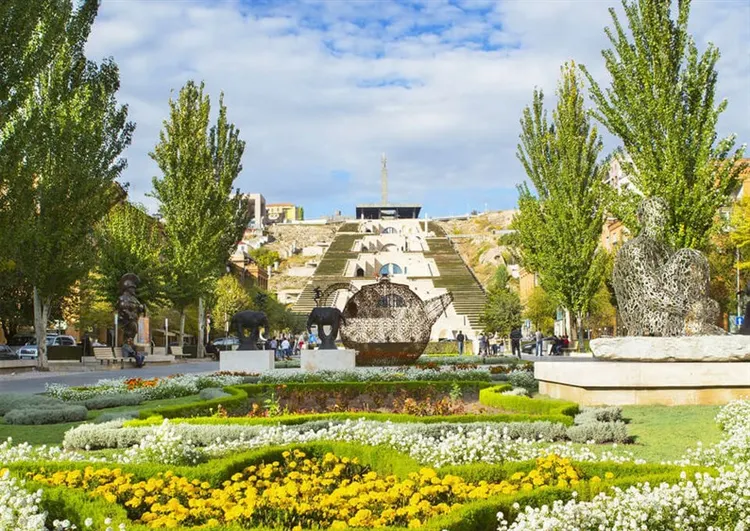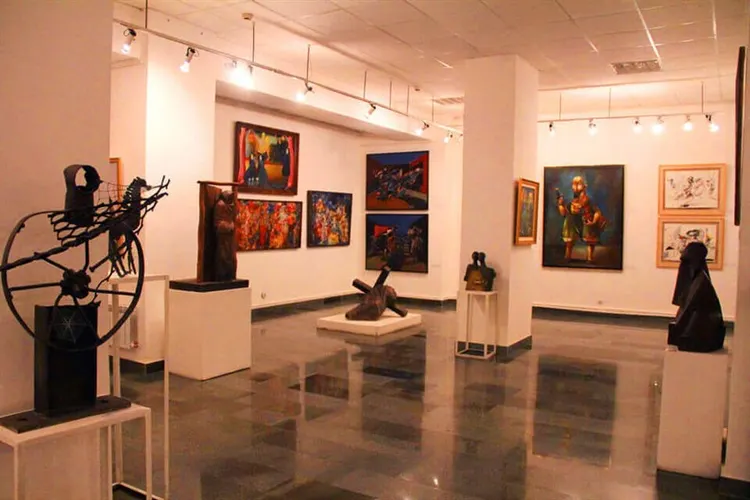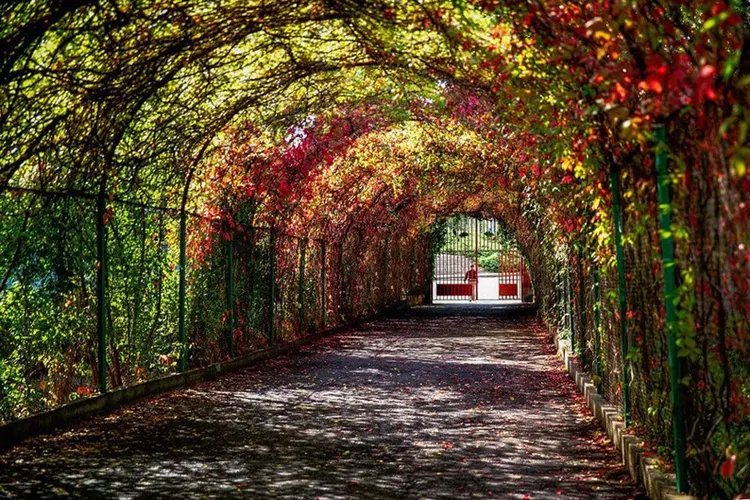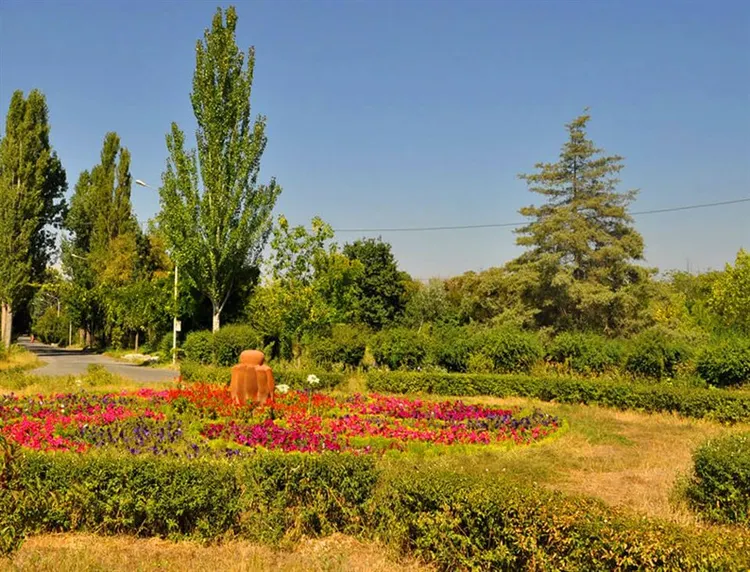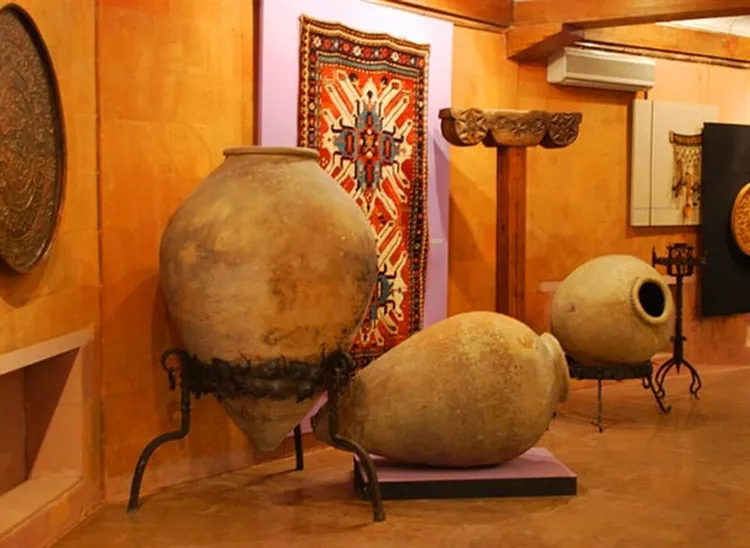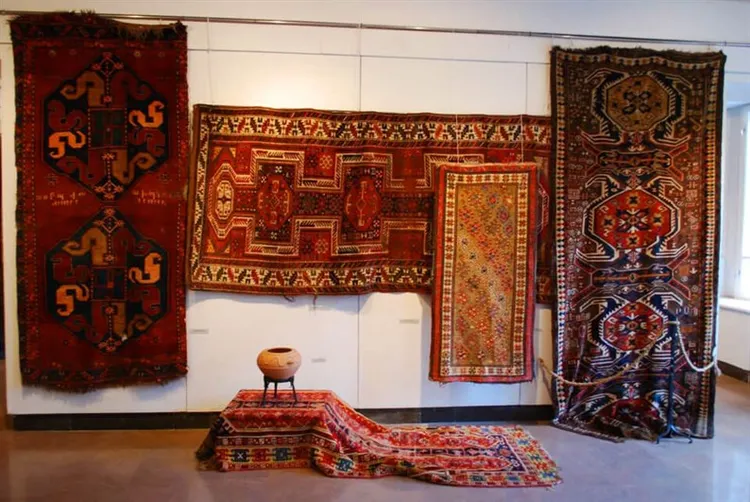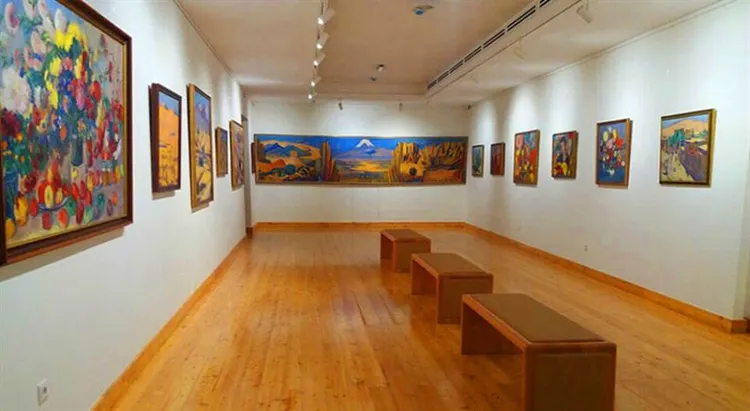Sights of Yerevan – 30 most interesting places
The city, located in two landscape zones on the left bank of the Araks River, is the oldest city in the world. Its history began with the fortress of Erebuni, which was founded by the king of the ancient state of Urartu – Argishti I. Reliable information about this was discovered during the dismantling of the ruins: a cuneiform text on a massive stone slab contained a message about the construction of the fortress. Judging by the remains of the fortress, Erebuni was in the place where the southern outskirts of Yerevan are now located. The city of unique buildings made of multi-colored tuff, having survived more than one tragedy, began to actively develop and grow after joining the USSR, turning over the decades into the beautiful capital of Armenia. The unique sights of Yerevan, embodying the past and present, attract a keen interest of tourists.
Big Cascade
Not every capital of the world can boast of such a unique structure as the Grand Cascade architectural and stair complex. The grandiose construction of incredible beauty and originality is a bright modern landmark of the capital of Armenia. A multi-stage staircase made of tuff of noble shades descends from the top of the Kanaker hills to Tamanyan Street, where a monument to the national architect of Armenia A. I. Tamanyan is installed in the square.
The staircase connecting the upper districts of the city with the lower ones is the center of the entire cultural and architectural complex, which includes fountains of amazing beauty, monuments, obelisks, museums, parks and squares. The construction of the Cascade began in the 80s of the last century and was completed only in 2009. The objective reasons for such a long-term construction were the terrible earthquake of 1988, the collapse of the USSR and the problems that piled on the country. The stopped construction was resumed in 2002, when an American with Armenian roots, J. Cafesjian, acquired the rights to it.
According to his plan, premises for a gallery of ancient art were equipped under the stairs, and the upper part of the Cascade became a place for demonstrating the works of modern creators. Now there are interesting sculptures of modern avant-garde artists, in particular, Fernando Botero (South America). His expressive sculpture “Black Cat” evokes rave reviews from the public.
Book a private transfer from the airport to your hotel for 1 200 RUB
Blue Mosque
The symbol of Iranian-Armenian friendly ties, the Blue Mosque, so named because of the color of the dome lining, was erected in 1766 by order of the governor of the Erivan Khanate Qajar on an area of 7 thousand square meters. m. Now it is the largest functioning mosque in the entire Caucasus. Initially, the building of the mosque had 4 minarets, of which only 1 has survived to this day.
Three domes rise above the Muslim cathedral, lined with blue faience tiles with majolica. The minaret, 24 m long, is located in the southeastern wing of the mosque, where pavilions (28) are also located; in the northern wing – a library where those who wish to study the Persian language; and an exhibition hall displaying various Muslim arts and crafts.
The southern part of the cathedral is a large prayer hall, where Yerevan Muslims come for festive prayers. The inner courtyard of the mosque, overshadowed by a century-old mulberry tree, a favorite place of the genius of Armenian poetry Yeghish Charents during his lifetime. In Soviet times, the building of the mosque was occupied by the Museum of History and Nature, then by the planetarium, but since 1995 the Blue Mosque has again become an active center of spiritual Muslim culture.
House Museum of Aram Khachaturian
Khachaturian's music has absorbed the Caucasian temperament, oriental sadness, sincere tenderness, fiery passion, majestic restraint and the brightest expressiveness. Suffice it to recall his uniquely exciting waltz to Lermontov's drama “Masquerade”. Is it possible to listen indifferently to the truly magical “Saber Dance” from the ballet “Gayane”, the striking rhythm of which is combined with the lyrical beauty of sound?!
All the music of the great musical genius will long excite the hearts of listeners. Despite the fact that the composer, conductor, musician and arranger did not always live in Armenia, he did a lot for ancient Armenian folk music, breathing new life into it. Grateful countrymen opened the Khachaturian Museum in the year of his departure (1982) in the house where his older brother Vaginak lived
After the opening, all the years the museum is replenished with exhibits related to Aram Ilyich. Literally from all over the world they are given by admirers of the genius composer's talent. An example is the story of the Pleyel piano. During the composer's tour in Brazil, he was invited to visit by the famous antiquary of Sao Paulo – Mostijyan, who bought a musical instrument on this occasion. Khachaturian played on it, and then, at the request of the owner, he scrawled his autograph on the piano lid.
Zoo
The most picturesque place with rich flora and fauna is the zoo, founded back in 1941 at the suggestion of Professor Sarkisov. The war stopped large-scale construction for 4 years, but then active work began on equipping the zoo on 25 hectares. As a result, a superbly designed area with enclosures, pools, sculptures, fountains, children's carousels was formed.
About 2,500 various trees, 3,000 ornamental shrubs and perennial flowers were planted here. Now the zoo is a real oasis, where almost 3,000 individuals of three hundred species live, including mammals, birds, reptiles, invertebrates, and fish. The composition of the inhabitants is constantly expanding: in honor of the 70th anniversary of the zoo, ibexes, mandrills (a species of monkeys), lemurs, flying dogs from Egypt, which now give healthy offspring, were purchased.
Zookeepers try to create an environment as close as possible to wildlife: treats for animals are hung up or packed in cardboard boxes so that the animals move actively, “getting” food. On holidays, the zoo turns into an arena of interesting performances, attractions, animation performances and various shows. All visitors, regardless of age, expect only positive emotions and unforgettable impressions here.
Erebuni Fortress
Like any city with an ancient history, Yerevan has its ancestral home in the form of the thousand-year-old ruins of the prehistoric Erebuni fortress, located on the Arin-Berd hill and covering an area of 100 hectares. Judging by the remains of fortifications, the city-fortress was created on a scale worthy of a strong and influential ruler, such as King Argishti I (782 BC) in the ancient state of Urartu. Such a conclusion can be drawn from the largest buildings of Erebuni – the royal palace and Susi temple, where luxurious highly artistic murals, exquisite ornaments made with expensive paints have been preserved.
The most valuable exhibit is a piece of a slab on which a text informing about the founding of the fortress is engraved in cuneiform. Many ancient relics illustrating the civilization of Urartu are located in the Erebuni Museum, located on one of the slopes of the hill. In the ancient fortress, everything is imbued with mysterious mysteries that have not been fully revealed, so it attracts thousands of pilgrims.
The way up is not so easy, so you need to calculate your physical capabilities. There is still no developed infrastructure here: you need to take water and food with you when going up to the fortress. Despite these inconveniences, touching the distant past leaves a deep emotional imprint on the soul.
Monument “Mother Armenia”
The Second World War did not bypass Armenia, which sent to the front many of its citizens who gave their lives for the victory in the war against fascism. The Mother Armenia monument is a logical embodiment of the idea of peace, expressed in the theme of majestic sculpture. Once upon a time, on the site of this monument, there was a statue of Stalin, which crowned the avenue of the same name, which replaced Armenian Street.
Unlike the sculpture by Mamaev Kurgan, “Mother Armenia” sheaths the sword, and does not hold it above her. This gesture and the shield lying at her feet are symbols of peace, a conditional call to life without war. Unfortunately, at the end of the 80s of the last century, Armenia again had to go through the horrors of a terrible fratricidal war in Nagorno-Karabakh.
At the foot of the monument, the Museum of the Armenian Ministry of Defense is opened, where military trophies, personal belongings, uniforms and portraits of war heroes are exhibited. Unique archival documents, weapons, front-line letters from soldiers are presented. Next to the sculptural monument is the Tomb of the Unknown Soldier, on which the Eternal Flame burns. A huge number of people of different ages flock here on memorable dates for Armenia.
Museum of the Armenian Genocide
On one of the green hills in the vicinity, the Genocide Memorial Museum is open, dedicated to the unprecedented atrocities shown by the Turks against the Armenians from 1915 to 1922. Over the years, almost 1.5 million Armenians living in the territory of the Ottoman Empire died in the massacre. It was a cruel revenge of innocent people for the defeat of the Turks in the battles near Sarykamysh with the Russian troops, who were assisted by the Armenians. The whole world recognized that it was genocide by the Turks and condemned the Young Turk government for its insane cruelty.
By the 80th anniversary of the terrible tragedy, a 2-story building was built, symbolically almost completely located underground, like a burial crypt. Allegorical is the form of the internal structure in the form of circles of hell, which the unfortunate victims of the genocide, who died under the knives, had to go through. The semi-basement premises of the first floor are reserved for administrative and technical services, a library, archive and storage. There is also a conference hall that can accommodate 170 people.
All museum exhibits are placed in 3 halls of the 2nd floor with a total area of 1000 sq. m. It is impossible to see mournful photographs without emotional excitement; read newspaper headlines; flipping through books about brutal executions.
Sergei Parajanov Museum
The name of the extraordinary artist and stage director Sergei Parajanov became widely known to the Russian public only at the beginning of perestroika. Prior to this, the avant-garde works of a talented creator with an unusual artistic worldview were not popularized in the USSR. His film Shadows Disappear at Noon was an emotional shock to moviegoers, as was The Color of Pomegranate.
The house-museum is located on a high cliff above the gorge, from where you can see the enchanting surrounding landscapes. The 2-storey building was built specifically for the artist, who did not have time to live in it. One of Parajanov's close friends, Sargsyan, having become the director of the museum, is painstakingly working to expand the collection.
The photographs of the last 14 years of the life of the genius, taken by Sargsyan, give a broad idea of the great son of Armenia. His original collages, paintings, installations reveal the rich inner world of the artist, help to better understand the meaning and ideas of his works. Here, the gray reality, from the angle of the artist's special vision, turns into a bright, joyful, life-affirming atmosphere.
Singing Fountains
A delightful spectacle in the center is the Singing Fountains, a man-made miracle of Armenian design engineers and architects who decorated the main square of the capital with their brainchild. The water-musical extravaganza, which begins in the evening, attracts crowds of residents and guests of the city. Fascinated by the magical play of light and soulful music, to the beat of which multi-colored jets of water move, people look as if spellbound at the perfect creation of the human mind and hands.
The merit in the creation of a unique structure belongs to a group of enthusiastic engineers led by a well-known professor in the country, Doctor of Technical Sciences Abrahamyan. They took the “singing” fountains of Germany as a basis, adding their technical “zest” and created a real masterpiece of this kind. The musical accompaniment includes magnificent examples of classics, national motives, rock and pop music at its best.
A stunning evening show at the end of the curtain is accompanied by the immortal chanson of the great countryman of the Armenians Charles Aznavour “Eternal Love”. We must pay tribute to the French diaspora of Armenians for the restoration of fountains in 2007, in which a lot of money was invested. Thanks to this, the wonderful “Singing Fountains” continue to captivate and enchant the inhabitants.
Sculpture “Man from letters”
As in other European capitals, in Yerevan, along with classical monuments of the past, there are avant-garde sculptures by contemporary authors, installed at the foot of the Grand Cascade. One of these sculptures is the “Man of Letters” by the Spanish modernist sculptor and artist Jaume Plensa, already well known in Europe for his unique works. “The Man of Letters” is a reduced copy of a French sculpture 8 m high (there are several such copies in the world).
The sculpture of a seated man is made of metal (stainless steel) letters of the Latin alphabet, chaotically connected into a single whole by welding. An unusual sculpture is irresistibly beautiful when it shines, penetrated by the rays of the sun, like a beacon of reason and knowledge. It is this meaning that the author put into his creation and did not lose. Sculptures installed in Moscow, Paris, Andorra enjoy the constant interest of the public. Residents have a reverent attitude towards their “Man of Letters”.
Temple of Zvartnots
Anyone who has been to Yerevan and seen the main sights, believed that all the interesting things are behind. But when he saw the Temple of Zvartnots, he was shocked to the core by the luxurious architecture of the ruins. The monumental beauty of the structures of the archaeological reserve, which Zvartnots is now, is simply stunning. It seems that there is nothing more beautiful in architecture than these ancient remains of the temple of “Heavenly Angels” (as Zvartnots sounds in translation).
The excavations carried out here revealed the priceless ruins of temple buildings erected under the Catholicos Nerses III in 641-661, known under the nickname “Builder”. Judging by the surviving magnificent columns with numerous decorations, this nickname was fully justified. According to legend, during the visit of the Byzantine emperor, he was so struck by the majestic beauty of the temple that he immediately wished to build the same in Constantinople. On the way, the invited architect died, and the emperor's plan did not materialize.
The temple was a round domed building made of light gray and black tuff, with three tiers with a total height of 49 meters and a diameter of the 1st tier of 35 m. The temple was based on a huge stepped pedestal, which has survived to this day in some places. A semicircle of 6 columns formed a cross inscribed in a circle, which symbolized the World. The lower tier of the temple was surrounded by a frieze with an intricate patterned bas-relief depicting pomegranate branches and vines, symbolizing the development of the world and man.
There are parts of the premises of the palace of the Catholicos, which can be used to judge its former grandeur. The ruins of the winery with large ceramic containers testify to the scale of wine production. Archaeological and restoration work continues on the territory of the ancient temple so that such beauty does not irrevocably become a thing of the past.
Freedom Square
Freedom Square appeared in the city at the beginning of the 20th century. Its main decoration – the Academic Opera and Ballet Theater – was built in 1933 on the site of the Getsemen Chapel. Opposite the majestic building, whose two-tier facade is decorated with arched ledges with pilasters and columns with capitals, bronze figures of the writer Hovhannes Tumanyan and composer Alexander Spendiarov sit on concrete pedestals.
Swan Lake is located near the Temple of Melpomene. With its shape, the artificial reservoir, named after Tchaikovsky's ballet, resembles the largest Caucasian lake Sevan. Weeping willows frame the shore, clad in granite, and tourists‘ cameras click on the picturesque humpbacked bridge. In 2015, American rapper Kanye West performed on the embankment, shocking the audience with his sudden jump into clear water.
The peak of the popularity of Freedom Square falls on the cold season. During the New Year holidays, a beautiful Christmas tree rises here, entertainment events are organized nearby. The lake turns into the only outdoor skating rink in the city. The indigenous inhabitants of the reservoir – white and black swans – go to the zoo for the winter, and figure skating enthusiasts take their place.
France Square
France Square is a tribute to the Fifth Republic, which in 1915 provided invaluable assistance to the Armenians fleeing the genocide. The opening ceremony of the square, which took place in September 2006, was timed to coincide with the official visit to the country of Jacques Chirac. After the solemn events, a grandiose open-air concert was given, in which Charles Aznavour took part.
Five years later Nicolas Sarkozy visited Yerevan. The President did not arrive empty-handed. As a gift, the head of France presented the city with one of the immortal masterpieces of Auguste Rodin – a sculpture depicting the artist Jules Bastien-Lepage holding a palette and brushes. The monument is an exact copy of the statue that Rodin installed on the grave of the painter in the village of Damville.
Cast in bronze, Bastien-Lepage rises in the center of the Place de France, one of the busiest intersections of the capital. From all sides, the sculpture is surrounded by the symbols of Armenia: Mesrop Mashtots Avenue, the National Opera and Ballet Theatre, the State Conservatory, monuments to Alexander Tamanyan, Aram Khachaturyan, Martiros Saryan, William Saroyan and Komitas.
Republic Square
The heart of the Armenian capital – Republic Square – was the best work of the architect Alexander Tamanyan. The central place of the city, which took 32 years (1926-1958) to build and equip, is famous for its monumental buildings. The festive look of the buildings, combining the style of neoclassicism and national flavor, is given by the decoration of white and pink volcanic tuff.
The basis of the architectural ensemble is the Government House, the Ministry of Energy and Foreign Affairs, the National Historical Museum, the Central Post Office and the Mariott Armenia Hotel. Stately buildings frame the pedestrian zone and the giant swimming pool. Not only tourists, but also locals do not bypass Republic Square.
It is especially crowded here on summer evenings, when the sun hides behind the tops of the mountains, and the beneficial coolness comes. From May to October at 21:00 the show of dancing fountains begins. Water jets shooting up to 50 meters are synchronized with lighting effects and music. The repertoire includes modern motifs and classical works. The colorful performance ends with the immortal masterpiece of Charles Aznavour – the composition “Eternal Love”.
Flea market Vernissage
You can buy souvenirs and get to know the unique flavor of “Armenian-style” trade at Vernissage, a flea market located a kilometer from Republic Square. In the 80s of the XX century, a bazaar was opened on this place, where they sold moth-eaten trash: clothes that had long gone out of fashion, rusted utensils, dried up books, hackneyed gramophone records and grandmother's porcelain cups.
Today Vernissage is a museum of history and a visual aid of folk art. The fair is filled to capacity with ubiquitous magnets, paintings, homespun textiles, traditional dolls, musical instruments, handmade jewelry, antique copper utensils, rugs and memorial tufa cross-stones. Tourist knick-knacks coexist here with truly unique things.
Exclusive cannot be cheap – for example, prices for collectible silver reach $ 2,000. Vernissage is open on Saturdays and Sundays, trading is conducted from 09:00 to 16:00. In order to see enough of the colorful curiosities, it is worth setting aside a whole day for a market trip. Numerous tents with drinks and national fast food will not let you get hungry.
Sakharov Square
At the intersection of Pushkin, Vardanants and Nalbandyan streets, there is a small Sakharov Square – a kind of “gallery” of architectural styles that have dominated Armenia over the past 60 years. Thus, the buildings of the Administration and the Fire Bureau, located on the southern and eastern side, absorbed the best features of the “provincial classicism”, popular in the 20-40s of the 20th century.
Until 1990, the square was named after Azizbayov, leader of the Azerbaijani revolutionary movement. The monument to the Baku commissar erected in 1932 was dismantled in 1988, during the height of the Karabakh movement. A year later, after the death of academician A. D. Sakharov, the city authorities decided to rename the square in honor of the famous scientist and human rights activist.
In 2001, the first monument to Sakharov in the Soviet Union appeared in the center of the square. The authors of the monument are Levon Galumyan, Ferdinand Arakelyan, Nerses Charkhchyan and Tigran Arzumanyan. The opening ceremony was led by the Mayor of Yerevan and the Prime Minister of the country. About 5,000 people came to honor the memory of the great humanist and public figure, who was the first in the USSR to stand up for the legitimate demands of the Karabakh Armenians.
“I am French and Armenian,” said Charles Aznavour (Shakhnur Aznavourian) about himself. The musician was born into a family of ethnic Armenians who emigrated to France in 1923. The connection of the artist with his historical homeland has never weakened. During the powerful Spitak earthquake, the singer rallied Western countries that extended a helping hand to those affected by the natural disaster. In 2009, Charles took up the post of Armenian Ambassador to Switzerland.
In 2001, a small but very cozy semicircular square in front of the Moskva cinema was named after Aznavour, an honorary citizen of Yerevan and a national hero of the country. The hero of the occasion himself attended the festive events. And 12 years later, on the Avenue of Stars, which appeared here in 2010, the nominal star of the king of world chanson lit up.
Currently, Aznavour Square is one of the most popular places in the city. In the center there is a two-tiered fountain. It is framed by stone structures resembling flower petals decorated with figures of the signs of the zodiac. Giant chess and huge metal sculptures of a horse, a bull, a spider and a bear also give the highlight of the square.
Lovers park
On one of the largest arteries of the capital – Marshal Baghramyan Avenue – next to the buildings of the National Assembly and the Presidential Residence, there is the Park of Lovers (until 1995 – Barekamutyun (Friendship Park)). The new name of the recreation area was not given by chance. The cozy green corner is often visited by happily cooing couples and newlyweds in the company of wedding photographers clicking the shutter among romantic mini-waterfalls and well-groomed trees.
Silence and grace reigned in the park not always. At the end of the 20th century, this place was in a deplorable state. In 2008, the situation was corrected by philanthropist Albert Poghosyan, who financed the reconstruction of the city oasis. And the French landscape designer Pierre Rambach embodied the beauty of the picturesque landscapes of Armenia and the severity of traditional Japanese architecture in the restored park.
Today everything here is very “European”. The area of 2.5 hectares is crossed by comfortable paths covered with fine gravel and tiles. Graceful bridges are thrown across decorative rivers and lakes, neatly trimmed lawns are filled with various sculptures. The park regularly hosts art exhibitions, music festivals and open-air film screenings.
National Gallery of Armenia
One of the most striking structures surrounding Republic Square is a pompous neoclassical building built from volcanic tuff. The upper floors of this architectural beauty are occupied by the National Gallery founded in 1921. Her first exhibits were canvases taken from temporary exhibitions of Armenian painters. Now the collection includes more than 26,000 works of art.
The world of Armenian artists is presented in all its diversity. The National Department has about 7,000 paintings, among which are ancient frescoes, medieval miniatures, works by masters of the New and Recent periods. The heart of the exposition is the second largest (after the Feodosskaya Gallery) collection of paintings by Ivan Aivazovsky (Hovhannes Ayvazyan). In addition to the masterpieces of the famous marine painter, the walls of the museum are decorated with canvases by Hakob Kojoyan, Martiros Saryan, Panos Terlemezyan, Gevorg Bashindzhakhyan.
The department of European and Russian masters includes works that came out from under the brush of famous masters. The names of Rubens, Donatello, Strozzi, Tintoretto, Levitan, Serov, Bryullov, Chagall sound like heavenly music for admirers of world art. In addition, visitors to the gallery will find extensive expositions of sculptures, graphics and arts and crafts.
English park
The oldest park – the English (Theater) Park – celebrated its 160th anniversary. A green oasis appeared on the map of the capital in 1860, becoming a fragment of a large public park that stretched to the most fashionable part of the city – Astafyevskaya Street (now Abovyan). Cozy mansions, private shops, expensive restaurants and luxurious houses created a unique sedate atmosphere of old London.
With the advent of Soviet power, the park was renamed in honor of the valiant Baku commissars. The historical name of the recreation area was returned only in 1991. Today, the English Park makes a double impression. On the one hand, the territory strikes with cleanliness and freshness. There are wide shady alleys, a fragrant rose garden, a children's section, a fountain and the Sundukyan Theater – the largest Melpomene Temple in the country.
Zones reminiscent of shots from old films contrast with European measured and well-groomed areas. These nostalgic corners are a favorite place for retirees who come to the park to relax, breathe fresh air and chat with peers.
Victory Park
Climbing to the very top of the famous “Cascade”, you will find yourself at the entrance to the Akhtanakh Park, which means “Victory Park” in translation. It got its name in the 1950s. In Soviet times, the oasis, overgrown with dense vegetation, was the largest green area in the capital.
As a guardian of the city, the monument “Mother Armenia” rises on a 51-meter tuff pedestal, which in 1967 replaced the statue of Stalin. The copper figure of a woman holding a huge sword in her hand embodies the stamina and masculinity of the Armenian people. At the foot there is a museum, the exhibits of which are dedicated to the years of the Great Patriotic War and the conflict in Nagorno-Karabakh. Nearby, at the Tomb of the Unknown Soldier, the Eternal Flame blazes. To the side stretched the Alley of Heroes.
The second attraction of the park is Arevik Lake. Until 1969, all the townspeople, from young to old, bathed in an artificial reservoir 8 m deep. Chlorinated water was used to irrigate local vegetation. Now you can ride a boat and a catamaran on the mirror surface. There is a recreation area next to the lake. Everything is standard here: well-groomed alleys, small cafes and various attractions.
Matenadaran
Translated from the ancient Armenian language, the word “Matenadaran” means “book depository”. That is why the museum was so named, in the archives of which there is one of the largest collections of manuscripts on the planet. The treasure trove of world culture was created in 1921. Its base was the collection laid down in the 5th century by the founder of Armenian writing Mesrop Mashtots.
Even the building itself, whose walls contain the rarest manuscripts, is admirable. Built in 1957, it is designed in the traditional style of medieval architecture. At the foot of the structure, there is a sculpture of Mashtots introducing the alphabet to his beloved student Koryun. The stone facade is decorated with basalt figures of prominent figures of science and art.
The rarities of the Matenadaran will interest those who are not indifferent to the “traditions of ancient times.” The museum fund includes about 17,000 manuscripts, 100,000 archival documents and centuries-old folios, as well as ancient samples of fabrics, jewelry and leather embossing. Among the treasures of the collection is the 27.5 kg book “Sermons of Mush”, written in 1200, and a 19-gram matchbox-like church calendar of the 16th century.
Opera and Ballet Theatre. A. Spendiarova
An invaluable gift for art lovers will be a visit to the Opera and Ballet Theater, which adorns Freedom Square. The decision to create a stationary opera house was made in 1932. In January 1933, a grand opening took place, marked by the staging of Almast by Alexander Spendiarov.
The theater received its own walls in 1940. The magnificent semicircular building, designed by the architect Tamanyan, is a symbiosis of monumental buildings of the Stalin era and medieval buildings of the East. The interior decoration, designed in light colors, attracts attention with marble square columns and wall panels.
The stage of the Temple of Melpomene hosted the musical “West Side Story” and the operas “Oedipus Rex”, “La Traviata”, “Faust”. The first production of an independent ballet group, organized in 1934, was Swan Lake, after which a picturesque decorative pond nearby was named. However, the theater's repertoire is not limited to masterpieces of world classics. Spectators with great interest accept performances from modern authors of Armenia.
Cathedral of St. Gregory the Illuminator
In 2001, Armenia celebrated an important holiday – the 1700th anniversary of the country's adoption of Christianity. The construction of the largest Christian church in Transcaucasia was timed to coincide with this significant date. The construction, initiated by the Catholicos of All Armenians Galegin I, began in 1997. After 4 years, the church ensemble, designed for 1,700 people, was solemnly consecrated.
Although the cathedral is Orthodox, in its appearance you will not find the usual smooth contours, rounded domes and crosses shining in the sun. The grandiose building, designed by the architect Stepan Kyurkchyan, is distinguished by the strictness of geometric shapes, restraint of the color palette and a minimum of decor. The height of the temple complex consisting of bell towers and three churches is 54 m, the total area is 3,822 m².
Inside the cathedral, parishioners are greeted by spacious ascetic halls. Light enters through narrow Romanesque windows decorated with colorful mosaics. There are very few icons here, and there are no wall frescoes at all. In the vestibule there is a shrine in which the object of worship of Orthodox pilgrims rests – the relics of Equal-to-the-Apostles Gregory the Illuminator.
Yerevan brandy factory
Spicy lively taste, fragrant overflows of oak, prunes, raisins and honey, silky, slightly bitter aftertaste – all this characterizes the famous Armenian cognac. The drink, whose fame has long spread beyond the borders of the country, is rooted in the distant past. According to ancient manuscripts and archaeological finds, the production of joyful amber elixir on the territory of Armenia was carried out as early as the 15th century BC.
The modern history of Armenian cognac began in 1887. Merchant Nerses Tairyan created the first factory of alcoholic beverages in the capital, which in 1953 was named Yerevan Brandy Factory. Over the long years of its existence, its products have won 115 gold and 48 silver medals. Pot-bellied bottles with the label “Ararat” are known in 40 countries of the world.
You can learn the intricacies of the production technology of an authentic drink, taste standard and collection varieties, as well as purchase a coveted bottle with golden contents of various aging during a tour of the factory. The Russian-speaking guide will introduce you to interesting facts about the drink, show you the fragrant cellars and halls where centuries-old barrels and vessels are stored – witnesses of the birth of the famous production.
Cafesjian Center for the Arts
At the base of the staircase leading to the top of the Cascade is the entrance to an unusual museum. Its collection consists of 5,000 sculptures, paintings and installations, some of which are placed outdoors. Created in 2009, the art complex is very popular with tourists – two years after its opening, it received more than 1.2 million visitors.
The idea of creating the center belonged to US businessman Gerard Levon Cafesjian, who donated to the gallery a part of his personal collection of unique creations by contemporary authors. All exhibits are exhibited in two sections: the internal “Art Galleries” and the external “Sculpture Gardens”. The indoor halls feature installations, photographic works, avant-garde paintings, gigantic Swarovski pieces and the world's largest collection of glass works.
Opposite the Cascade, the Sculpture Gardens exhibit statues created by Stanislav Libensky, Paul Cox, Barry Flanagan, Fernando Botero, David Martin, Lynn Russell Chadwick. You can admire works of contemporary art every day from 8:00 to 20:00.
Modern Art Museum
Another eldorado for Modern Art lovers is the Museum of Modern Art, located on Mashtots Avenue. You can easily find the entrance to the gallery by looking at the creative graffiti drawings decorating the house built in neo-constructivist style. Inside, there are bright halls lined up one after another, whose white walls and strict lines contrast sharply with the variety of shapes and colors of exhibits.
The creation of the Museum of Modern Art dates back to 1972. At that time, on the territory of the USSR, where the style of socialist realism dominated, the directions of avant-garde, surrealism, modernism and futurism were prohibited, so the opening of an art gallery became a real sensation.
The collection is based on paintings and sculptures of the generation of Armenian artists of the “sixties”: Vruyr Galstyan, Minas Avetisyan, Ashot Hovhannisyan, Aratyun Kalents, Gayane Khachaturyan. Notable exhibits include Jean Garzou's controversial Red Room, Martin Petrosyan's Friendship and Akop Hakobyan's Train Station.
Botanical Garden
A wonderful option for a walk on a hot summer day is a visit to the Botanical Garden. The green area, covering an area of about 90 hectares, was founded in 1935. After the collapse of the Soviet Union, the further fate of the park was in jeopardy – funding stopped, and the energy crisis forced local residents to cut down trees for firewood. A change for the better was outlined in 1994, after the creation of the Center for Plant Biodiversity Conservation.
The local kingdom of flora impresses with its diversity. About 500 representatives of the tropical and subtropical flora are gathered in the greenhouse. A truly fantastic sight is colorful orchids, fragrant jasmine, unique grape vines and avocados. There are also the rarest exotics here – the Australian macadamia and the hand of the Buddha, whose unusual fruits look like long fingers hanging from the hand.
Gardeners and architects embodied in miniature models of all the natural regions of Armenia. Walking along the picturesque alleys, you will meet the juniper of the Ararat valley, and the juzgun of the Gorovan semi-desert, and the inhabitant of the Sevan basin, calamus. Many representatives of the flora arrived in a blooming oasis from China, Thailand, India and America.
Folk Art Museum
There is a unique art gallery on Abovyan Street, which stores samples of fine and decorative arts. This is the Museum of Folk Art, the formation of the collection of which began in the 30s of the last century. The cultural center received its own building in 1978.
In the unusual gallery there are no creations of professional artists and sculptors. All 12,000 objects included in the museum fund are the work of amateur craftsmen, for whom creativity is a favorite hobby and a way of self-expression. In their art, folk craftsmen have reached the highest level. This is evidenced by exhibits representing various eras of Armenian culture.
The exposition includes lace, chasing, ceramics, glass crafts, mini-sculptures, paintings in the style of naive art, pile carpets and carpets. Of constant interest is the collection of traditional jewelry made of precious metals, decorated with onyx, turquoise, garnet and obsidian.
House Museum of Martiros Saryan
The outstanding Armenian painter Martiros Saryan (1880–1972) is called a master of color and a luminous artist. The popular recognition of the master and his popularity among art critics were so great that in November 1967 a museum was opened in Yerevan, the collection of which included canvases, sketches, graphic works and book illustrations of the author. Today, the gallery's keeper is the artist's granddaughter, Sophia Saryan.
Saryan's paintings are an expression of national identity. The entire creative path of the artist was illuminated by love for the Motherland, its centuries-old history, marvelous landscapes, and, of course, people. Armenia occupies a central place in the master's work. The canvases take the viewer to small courtyards, valleys flooded with light, ancient monasteries and to the tops of mighty mountains.
The gallery has about 200 exhibits. In addition to the artist's works, his working tools and personal items are exhibited here: brushes, palettes, stretchers, grandfather clocks, antiques, and furniture. Under the glass atrium is the pride of the museum – part of the original creative workshop of the painter.
